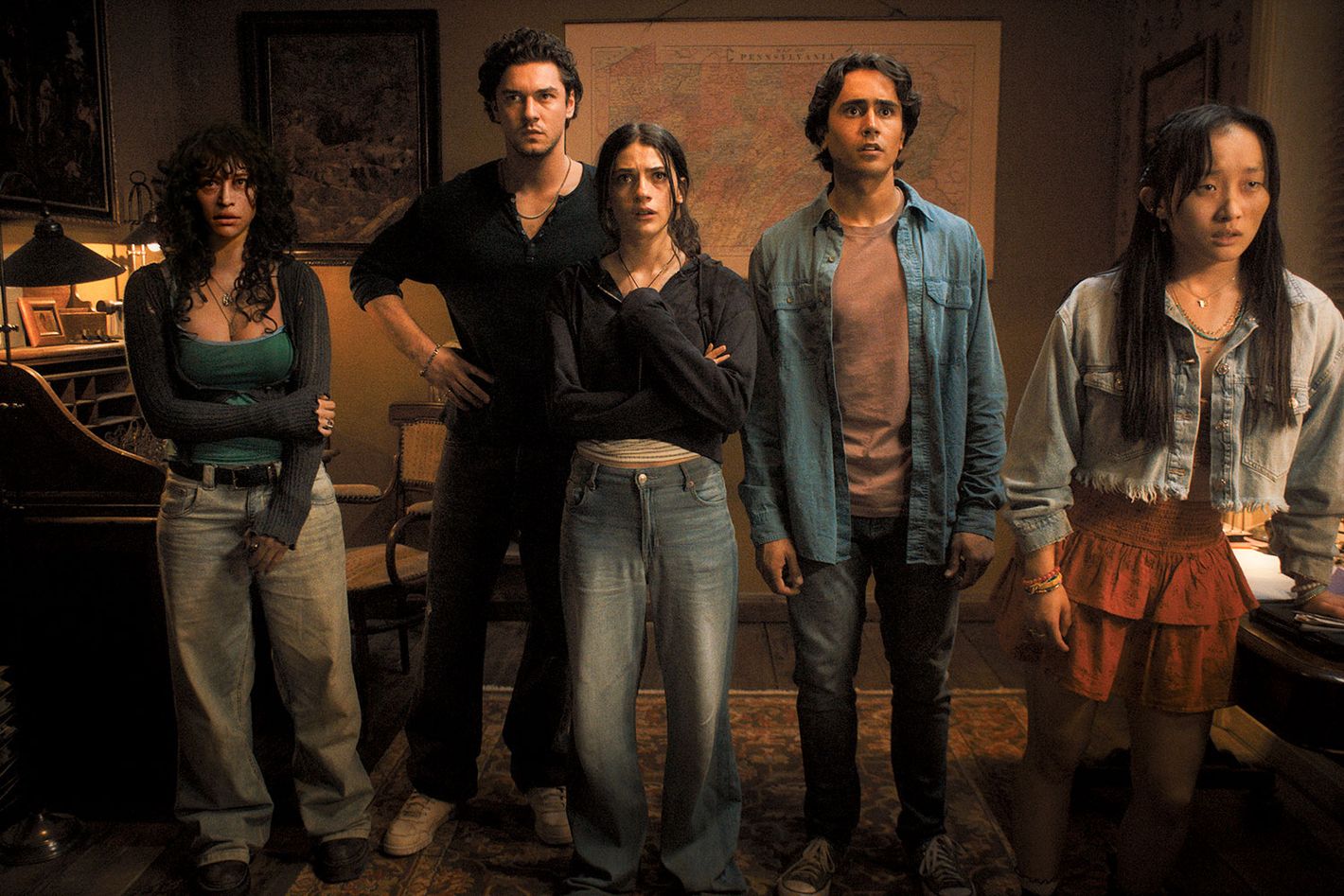Until Dawn’s Ending Turns Trauma Horror Into a Joke


Spoilers ahead for the plot and ending of Until Dawn.
If you’ve never played the 2015 survival horror game Until Dawn, the 2025 film adaptation might confuse you. Also, if you have played the game, the film adaptation might confuse you. David F. Sandberg’s Until Dawn borrows from its popular predecessor, but the script — from writers Gary Dauberman and Blair Butler — tells an original story, and one that’s not always easy to get a handle on. What starts as a classic slasher set-up becomes something else entirely, with a pile-on of ideas that threaten to collapse the movie under its own weight. By the end, however, Until Dawn is saved by its sense of humor, proving itself more akin to Cabin in the Woods than any number of weightier recent titles. Even as it dumps lore on its audience, the film pokes fun at the modern convention of serious, metaphor-laden horror. Just because the trauma is real doesn’t mean you can’t laugh at it.
Before things go off-the-rails, though, Until Dawn feels very familiar. Clover (Ella Rubin), Max (Michael Cimino), Megan (Ji-young Yoo), Nina (Odessa A’zion), and Nina’s boyfriend Abel (Belmont Cameli) are on a trip to explore the area where Clover’s sister Melanie (Maia Mitchell) vanished a year prior. When a gas station attendant (played by Peter Stormare, so you know he’s up to no good) warns Clover about disappearances tied to Glore Valley, a masked killer feels somewhat inevitable. Sure enough, soon after the friends find their way to an abandoned visitor center — filled with troubling clues, like a board covered in missing person flyers, including one for Melanie — the inevitable psychopath makes an appearance. In short order, he makes good use of the film’s R rating and brutally murders all five of them.
That may sound like the end of Until Dawn, but it’s only the beginning. With a twist out of Groundhog Day — or Happy Death Day, to cite a more relevant example — the unlucky group discovers that once they’re all killed, the night starts over again. “I’m pretty sure we’re fucked, guys,” Abel observes. An hourglass marks their progress; unless there are survivors when the time runs out, it flips over and begins another countdown. Unlike your typical time-loop story, however, things don’t stay the same. For one thing, the friends are each a little worse for wear after dying, with marks where their fatal injuries were, along with other signs their bodies are changing. For another, the threats of Glore Valley extend far beyond one masked killer. As the five soon discover, there’s a seemingly endless array of things that want to kill them, from witches and wendigos to parasitic worms and a kaiju-sized monster in the woods.
It’s a premise that could easily become monotonous, and there’s certainly a relentlessness to the onslaught of kills that ensue. Thankfully, there’s also a lot of creativity to the parade of gore. While much of the movie’s humor comes from its characters’ self-awareness, with ample meta-commentary throughout, the rest of the laughs are mined from the sheer absurdity of the violence it inflicts on them. In one of Until Dawn’s best sequences, the group discovers that they’ve been recording several of their most gruesome demises in cell phone videos, which they watch together as a harrowing clip reel. (Try not to think too much about the head-scratching logic of the cell phone conceit. This is good advice for the film as a whole.) The most memorable deaths in the movie arrive when the friends decide to wait out the night in the bathroom, carelessly drinking water from the sink when they get thirsty. Moments later, they each explode like water balloons filled with blood and viscera, a messy reminder that nothing in Glore Valley is safe.
To be fair, they’re also doing what you’re supposed to do in time-loop movies — or video games, since Until Dawn’s plot is clearly inspired by survival game mechanics. They’re investigating their surroundings to figure out what’s keeping them there and how they can make it through the night. It turns out that Glore Valley was a mining town until it was swallowed whole, killing nearly everyone, which explains the bad vibes if not the repeated deaths. Eventually, the group discovers that the gas station attendant is actually a shady psychiatrist named Dr. Alan Hill (Stormare reprises his role from the video game), and he seems to be the root of their suffering. In videos of Hill’s past psychiatric work, they see him document a patient who believes he’s being killed over and over again by all of his worst fears. He’s also changing, not only weakening from the “dying” but becoming something more monstrous. It echoes a warning Clover got from a witch who briefly possessed her (don’t worry about it): “You either survive the night or become a part of it.”
Those trapped in Glore Valley can only die so many times before they turn into something inhuman — specifically a wendigo, which is a reference to the Until Dawn game, but again, don’t worry about it — meaning the five friends have to figure out how to end this. On their 13th and final night, Clover realizes that she needs a face-to-face with Hill. To get to him, she has to travel through the underground tunnels that were once the town, battling and defeating her wendigo-ed sister before she arrives at the psychiatric hospital. Hill is all too willing to exposition dump since she’s made it this far. He’s been watching this group of friends on closed-circuit TV because he studies fear. When traumatized people (like Clover) are brought to this traumatized place (a mine collapse will do that), their psyche creates monsters. It’s Clover’s mind that’s doing the dirty work here: After the loss of her mother and Melanie’s disappearance, Clover struggled with depression and suicide attempts. Everything that she and her friends have experienced is real, but Clover and her trauma are the “engine” that’s powering the endless array of baddies.
The explanation is more than a little muddled — as I said, logistics are not Until Dawn’s strong suit — but there’s something refreshing about the film revealing itself to be trauma horror and not being afraid to get silly with it. Countless horror movies, particularly in recent years, have given us metaphor monsters and heavy themes that outweigh the scares. These movies are not about ratcheting up the tension; they’re about what it all means. For its part, Until Dawn is more concerned with having a good time through the unpacking of genre tropes, like its obvious predecessor, Cabin in the Woods. Moreover, the meta-horror approach helps make the big “it’s about trauma” reveal feel like a joke unto itself. The movie is not only satirizing the slasher genre, but also the 21st century horror tendency toward expressly stated feelings and pathos. How else can one read Hill’s explanation that the tap water that makes you explode is actually a manifestation of Clover’s self-destructive nature? The explosions themselves are played for laughs, and so is the Psych 101-level analysis. Is it that serious?
That’s not to say that there isn’t any sincerity in Until Dawn. In the end, this is a movie about overcoming trauma, with Clover confronting the loss of her sister head on — yes, that means killing her in wendigo form, but it counts — and discovering her will to live again. She moves Hill’s coffee cup to ensure a drop of water falls in, and we all know what that means. Once the evil doctor has exploded, Clover is able to reunite with her friends, with all five crawling out of the ground as the hourglass runs out. They’re survivors, but so, somehow, is Hill. The film ends with him watching a new group of victims arriving at the visitor center. Is there a deeper meaning here, a painful closing note to remind the audience that trauma endures? Maybe. It’s more likely, though, that Until Dawn is just angling for a sequel where more attractive 20-somethings can get killed in inventive ways. Really, what could be more healing than that?

Latest News
For Sale! 2016 Sea Ray 350 Sundancer – $180,000
Reel Deal Yacht is pleased to feature a meticulously maintained 2016 Sea...
Creating the Finest Yacht Instruments in the World
A+T Instruments: Crafting the World’s Best Yacht Instruments In the world of...
Why Miami is the Best Place to Buy a Boat
Miami has long been regarded as the ultimate destination for yacht and...
What Are the Best Floating Docks? How to choose for stability, safety and style
For most boat owners, a private pontoon is the dream: instant access...
Best family yacht: The best yachts for sailing with the family
Toby Hodges takes a look at all the nominees and the winner...











Leave a comment